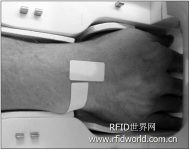
Swiss study finds that RFID tags can be safely used for MRI and CT scans
[ad_1]
Researchers at St. Gallen Canton Hospital in Switzerland found that high-frequency 13.56 MHz RFID tags will not have a significant impact on imaging equipment, and the equipment will not affect the tag function. This study was conducted by researchers from the University of Zurich and the hospital, and found that magnetic resonance imaging (MRI) radiation can increase the temperature of the surrounding tissues where the RFID tag is attached, up to 4 degrees Celsius, but it will not affect the health of the patient.
The quality of MRI images is minimally affected by the presence of RFID tags, the researchers said, only limited by the skin on which the tags are attached. Moreover, the label will not have any effect on the CT scan image. The results of the study were published last month in Patient Safety in Surgery-an online medical peer journal.
The results of the study, according to project leader Thomas Steffen, proved that patients can keep the RFID wristbands they wear during the diagnostic examination process-such as MRI or CT scans. Steffen first conceived the study in early 2009, with the purpose of proving whether the RFID tag MRT or CT scanning process will cause potential functional and safety hazards. The researchers also mentioned in the report that previous studies have indeed found that MR scanning will affect the implantation of low-frequency passive RFID tags under the skin.

Two RFID tags are attached to the volunteers’ wrists and scanned by MRT
The researchers chose the 13.56 MHz tag because it is most commonly used on patient wristbands. A total of 60 tags containing NXP Semiconductors ICode SLI chips were used in the study, which complies with ISO 15693 and ISO 18000-3 standards. The label is divided into two sizes, half of which contains 76 * 45 mm etched aluminum antennas, and the other half contains 31 * 14 mm etched copper antennas. According to Christian Kern, chief technology officer of InfoMedis, an RFID solution provider.

RFID generates only minimal shadows in MR imaging
In order to achieve the stability of the RFID tag test, the researchers first took 15 tags of each of the two types of tags, and used Feig Electronic’s Obid-MR100 readers to read them separately. Then, the 30 tags were scanned by the MRI machine and the CT machine. Finally, the reader reads the tag again. The researchers also divided the labels into groups of 5, pasted them on the four sides of a 300 * 215 * 80 mm cardboard box, and then scanned them. The MRT and CT scan labeling process uses a standard scan protocol, which is the same as the patient scan scene. The test was executed twice, and a total of 60 tags were used.
When testing the labels on the cardboard boxes, the researchers used CT scanners, and 1.5 and 3.0 Tesla MRT scanners, using standard protocols for brain scanning. The team also conducted a “worst case” label test-the MRI machine took up to 2 hours to scan the label. Exposure to X-ray radiation from MRI scans and CT machines, the tags maintain perfect functionality and complete data, Steffen said.
In the MRT scan, the researcher also tested on a volunteer and found that RFID tags did have some influence on the MRI images of the volunteers. Volunteers stick the label on the wrist. During MRI imaging, the label position creates a shadow, but the size is so small that it does not affect the quality of this type of diagnostic test. For example, the label will interfere with the visibility of the skin where the label is attached, but other parts are still clearly visible. Therefore, researchers do not recommend attaching the label to the area where the MRT needs to be scanned.
Another phase of the test studied the temperature rise of the tissue near the RFID tag. This part of the research was carried out by the University of Zurich. The label is affixed to a salt water container, a gel that simulates a human arm, and the sensor tracks the temperature change of the liquid. The labelled container is under MR radiation. The maximum temperature rise is approximately 4 degrees Celsius. This is completely acceptable to label wearers. When the volunteers were tested, the results were the same.
“We have concluded that the RFID wristband is safe for 1.5-T and 3-T scanners in normal operating mode,” the report said.
However, the researchers also warned that although the test label is most likely to be used in hospitals, considering the diversity of market labels. Other types of labels also need to be tested in different MR environments or other clinical conditions.
[ad_2]



